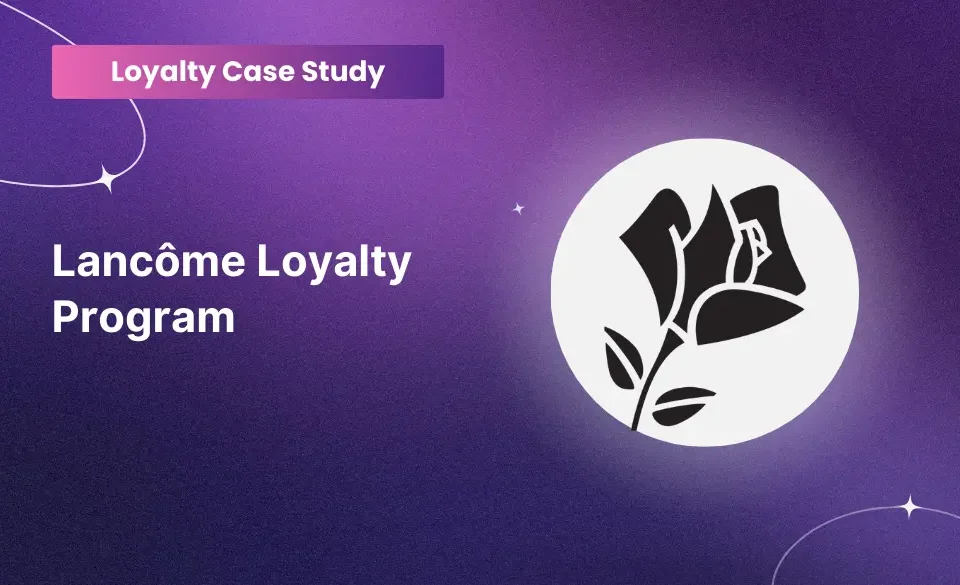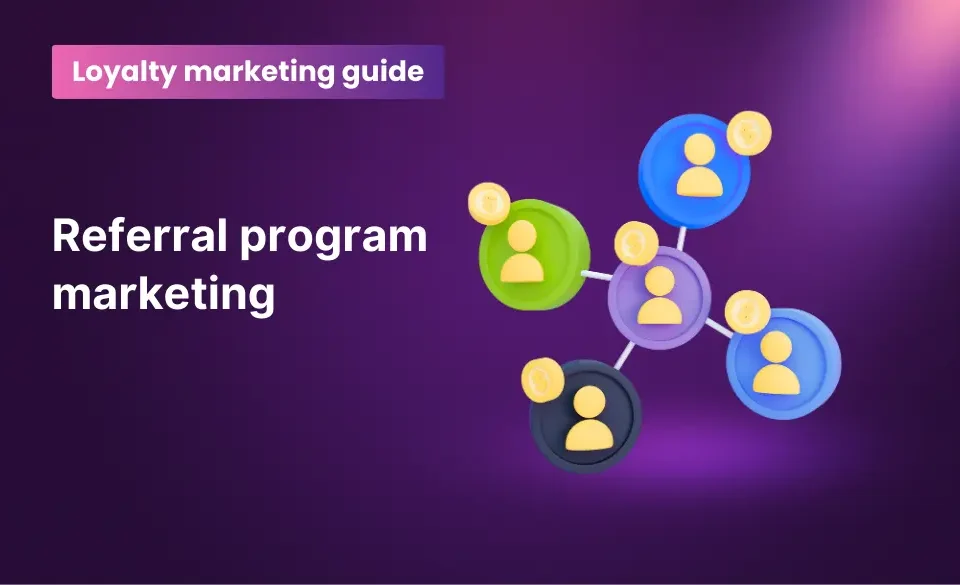
8+ Mother’s Day Marketing Strategy Drives Your Sales in 2024
20 May, 2024
How Much Does a Shopify Loyalty Program Cost? (2024)
24 May, 202482% of shoppers believe customer reviews and online reviews are more powerful than marketing promises. But how can small online businesses encourage customers to write useful reviews?
Don’t worry; this blog article is a one-stop shop for boosting your review generation. We’ll discuss 14 ways small companies can get more reviews, from clever incentive programs to social media.
Let’s start!
The Power Of Customer Reviews In 2024
In today’s digital world, when internet shopping reigns supreme, establishing trust with prospective consumers is more critical than ever. Enter the power of customer reviews. These tiny morsels of customer experience (CX) have a significant impact on purchase decisions.
There are two things you need to know:
Why Do Online Reviews Matter More Than Ever?
Consumer trust is of the utmost importance in this era of internet purchasing. Before purchase decisions, 99.9% check online reviews as social proof, with 50% of customers trusting online reviews as much as personal recommendations from friends and family. Trust undoubtedly leads to sales since shoppers choose shops with a brand reputation.
Also, online reviews are compelling; they are e-commerce SEO ranking. Google and other search engines rank websites based on the quality of reviews. That means positive online reviews are a search engine magnet, drawing organic traffic to your company.
But it’s not always easy for online stores to get consumers to provide feedback. This problem will be dealt with in the next part.
The Challenge Is Encouraging Customers To Leave Reviews
Without a doubt, not every online buyer, whether they have good or negative reviews, wants to write them. Online businesses struggle when customers post online reviews at low conversion rates because of these things:
- Natural forgetting: Even if they are customer-satisfied, they may not remember sharing their excellent reviews online. For this reason, it takes at least two requests to get 58% of customers to submit an online review.
- Time constraints: Easy review submissions encourage customers to leave them.
- Lack of motivation: Even if positive reviews are appreciated, a discount voucher or contest entry may encourage customers to leave more reviews.
Growing a successful online review scene is hard work, but the benefits are often worth it. In the next part, we’ll talk about some ways to get customers to write reviews.
14 Strategic Ways To Encourage Customers To Write Reviews in 2024
Here are 14 best practices for encouraging customer reviews in 2024 on your Shopify store:
1. Highlight The Value Of Reviews
As we know it, online reviews have an enormous influence on buyers. Let’s show customers how much their online reviews matter by displaying favorable comments on product pages where consumers shop.
Also, explain how these reviews from past customers help other people make better drive reviews.
As Lauren Triance-Haldane of PathFactory says:
“Before the vendor sends out a review campaign, we send a heads-up email to our customers letting them know we’re about to run a review campaign, asking for their participation, and explaining why it’s beneficial to everyone to leave reviews,”
Look at Love Book as an example. They use a subtle prod in their introduction emails to get people to share their books as online reviews on social media and tag @LoveBookOnline.
This is a clear call to action as a personalized invitation to join a community of like-minded readers.

2. Seed Reviews With Micro-Influencers
Every online shop wants organic customer feedback, but a small push may assist. So, “seeding reviews” using micro-influencers comes in.
The Journal of Marketing Research found the right way to seed that works eight times better. These micro-influencers can give honest reviews. That makes potential customers more inclined to buy and post reviews.
However, forced or inauthentic reviews might backfire. So, stay away from manufactured testimonials and high expectations. Instead, build real relationships and let micro-influencers share their honest product experiences.
Look at how La Croix, a famous brand, partnered with micro-influencers (under 1,000 followers) to build a strong network of positive internet reviews.

This is how La Croix uses micro-influencers, which shows how well they work. Including real people’s words in reviews could lead to natural customer feedback, build trust, and increase sales.
3. Integrate Review Widgets With Social Media:
We’ve already covered the possibility of using micro-influencers to “seed” reviews to encourage more natural consumer feedback. What if this impact could be amplified? The answer lies in integrating review widgets with social media.
Here we go again with La Croix as an example. The “Live LaCroix” section on their website features content created by online micro-influencers. It showcases videos produced by micro-influencers across various platforms.

No doubt, these real reviews serve as testimonials, boosting confidence and luring in new La Croix fans.
Someone may ask, “How can I put this into action?” at this point. For a list of prominent options and what they provide, see the “Partner with Review Platforms” section down below.
4. Personalized Review Requests With A Human Touch
Personalized requests can lead to a 7.6% increase in response rates. That translates to a significant boost in the number of reviews for your online store, building trust and driving sales.
Here’s how to add a personal touch to your review reminders:
- Address customers by name.
- Check their purchase: Give general encouragement, such as “We appreciate your opinions! Leave a review to assist others.” “Loved your purchase? Write a review!” or “Tell us what you think!”
- Offer friendly support: After reading the review reminder, tell consumers you’re ready to address questions. This builds trust and shows customer service.
Take Chapelle Jewellery in their successful review request email as an inspiration.

Customers will feel more connected to your company and see that their opinions matter when you take the time to respond personally.
Check out another section on personalized review requests utilizing review management solutions.
5. Offer Early Access Or Exclusive Content
The idea of exchange is very important to how people act. When someone gives us something useful, we often feel we need to return the favor. That’s why, for 73% of Millennials, an incentive would drive them to submit an online review.
Here are some creative incentive ideas:
- Early access.
- Discount codes for future purchases for a review.
- Exclusive content: Create e-books, recipes, and instructional manuals for reviewers only.
Also, you incorporate reviews into your loyalty program. We’ll delve deeper into specific strategies and implementation tips in the “Gamification And Loyalty Programs” section below. Stay tuned.
6. Leverage User-Generated Content (UGC)
Did you know brand interactions increase by 28% when consumers see both professional marketing material and user-generated content? This shows how important user-generated material is.
Here are some techniques for encouraging consumers to contribute user-generated content:
- Branded hashtags: Make a unique hashtag for your brand or product line. Then, promote it on your website, packaging, and social media to boost use.
- Eye-catching visuals: Use high-quality product photographs and videos on your website and social media to encourage consumers to generate their own UGC.
- Feature UGC on your platforms: This rewards consumers and promotes involvement.
Think about La Croix once again. They encouraged followers of the sparkling water brand to express their enthusiasm for the product on Instagram by using branded hashtags such as #LaCroixLove and #LiveLaCroix.
La Croix even highlights some of the best pictures uploaded by users, with the possibility of using them in their advertising. This encourages high-quality material and fosters La Croix-fan relationships.
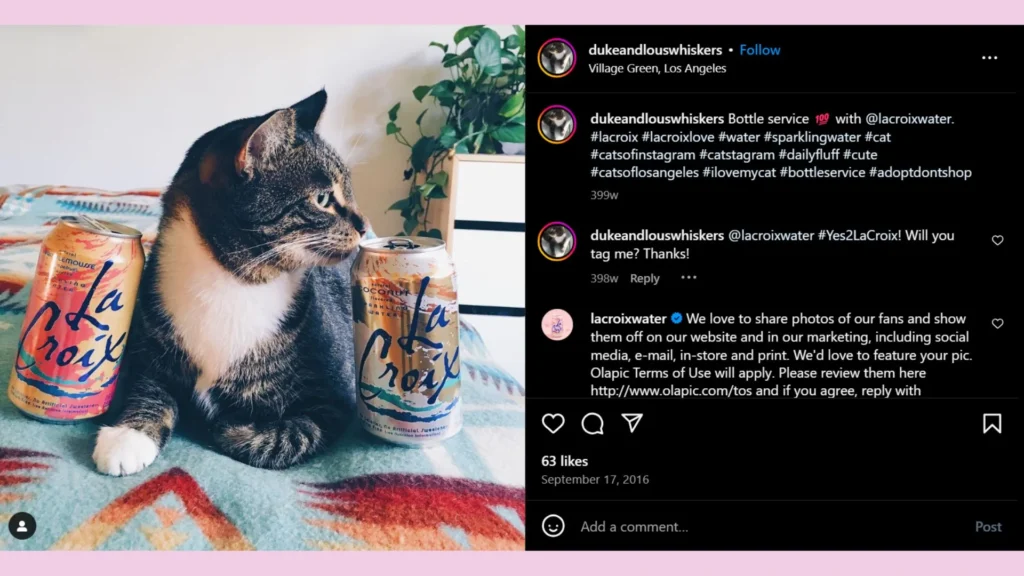
7. Gamification And Loyalty Programs
We’ve tried several ways to get customer reviews, but what if we added some fun? Gamification may enhance review volume and consumer engagement by applying game-like aspects to non-game circumstances.
Use elements like points, badges, leaderboards, and challenges to make evaluating a product more enjoyable.
Many successful brands, like Arken Optics for example. This successful business incorporates a gamified table of their tiered loyalty program is on their website.
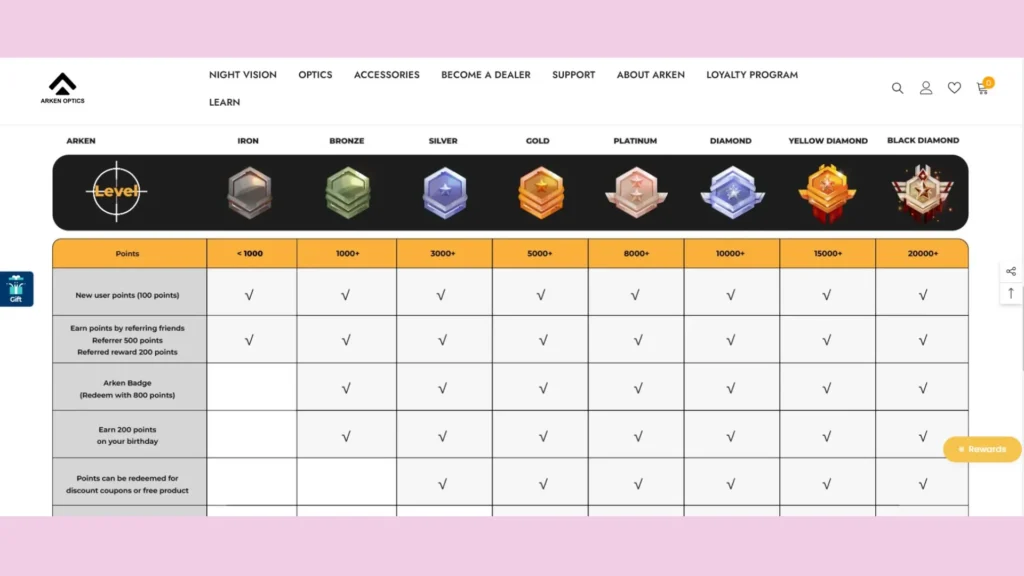
8. Contests And Giveaways
This is a natural drive that contests and gifts play on. For example, you may organize a contest to choose the “Most Helpful Review” or the “Most Creative Review with a Photo/Video.” This involves giving useful and interesting reviews that help your store and possible customers.
Take Living Spaces, a furniture store, for example. They provide a weekly contest in which one fortunate reviewer gets a $500 gift card. This interesting reward is likely to attract attention.
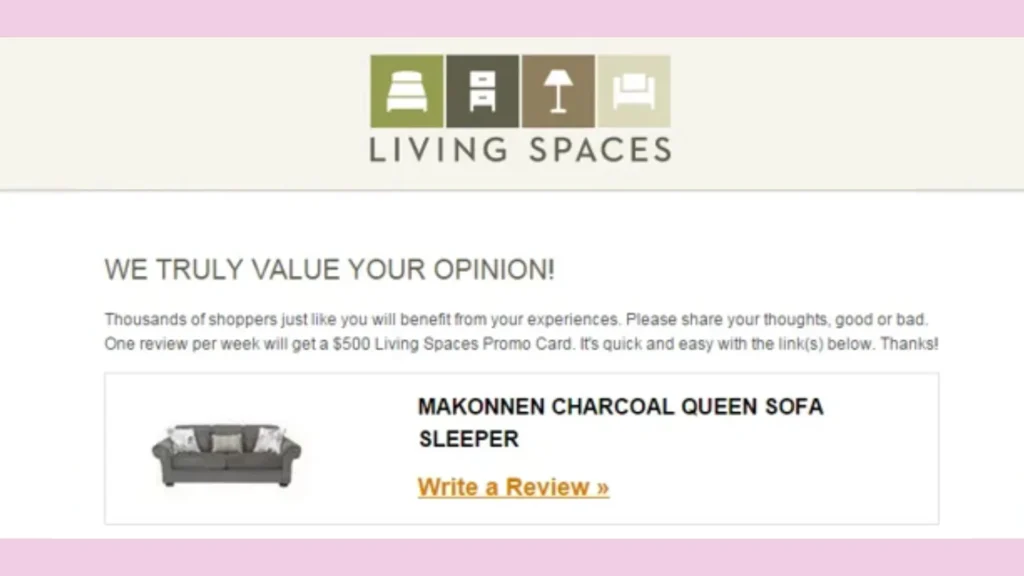
Plus, Living Spaces connects to recently acquired items in review request emails. This reduces unnecessary work and makes the review process easier for customers to participate in.
9. Respond Promptly And Publicly
A company’s online review response made 89% of customers “very” or “fairly” inclined to use it again. A public and prompt response to feedback from customers demonstrates that you care about their opinions and invites them to participate.
Do not be afraid to answer bad reviews. Respond within 24-48 hours, displaying your responsiveness and dedication to addressing difficulties. Listen to the customer’s complaints and apologise if you caused any trouble. Expressing genuine regret shows that you value their feedback.
Home Depot is a well-known example of a firm that values its consumers’ opinions. The customer was informed to pay extra for the right item after receiving the wrong one, as stated in the review.
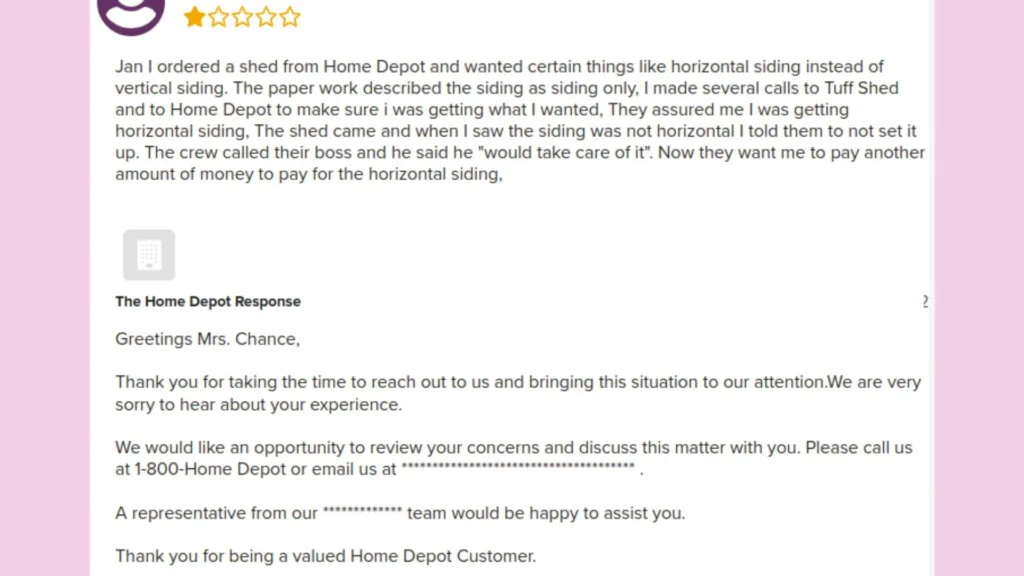
Their post-review response strategy is to apologize for the reviewer’s unpleasant experience. Also, their rapid and professional answers encourage the consumer to contact them and provide customer service contact details.
Contact information is optional but shows respect for the customer’s time and a genuine desire to follow up.
10. Showcase Positive Customer Interactions
By prominently displaying positive customer evaluations on your website, product pages, and social media sites, you may establish credibility with future consumers.
As an example, consider DeathWish Coffee. To allow reviews directly on the product page is a fantastic move on their part. Customers are more likely to provide honest feedback when the review procedure is simplified.
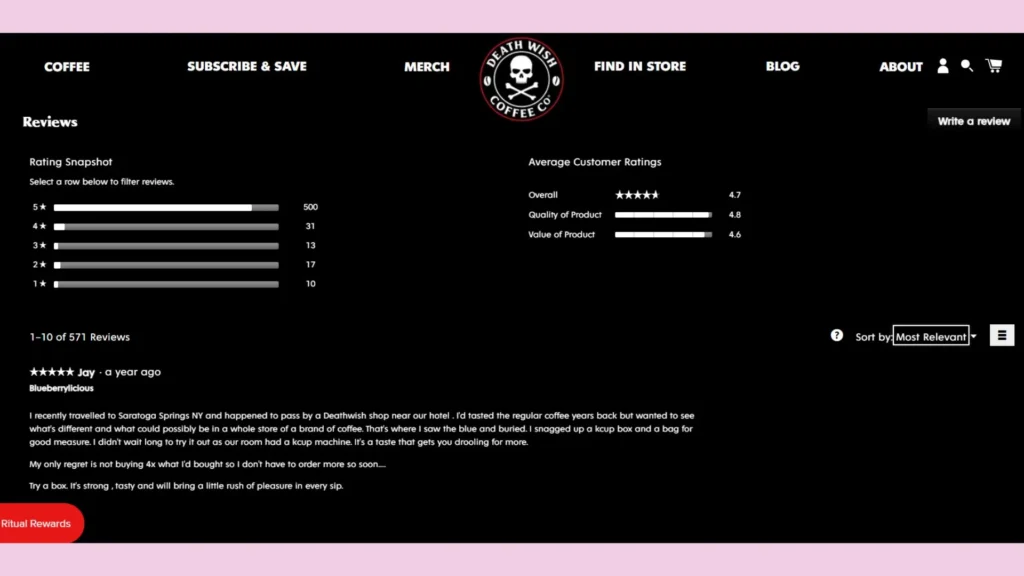
Take HelloFresh as an example; the company integrated social media reviews from customers using the hashtag #HelloFreshPics on its webpage.
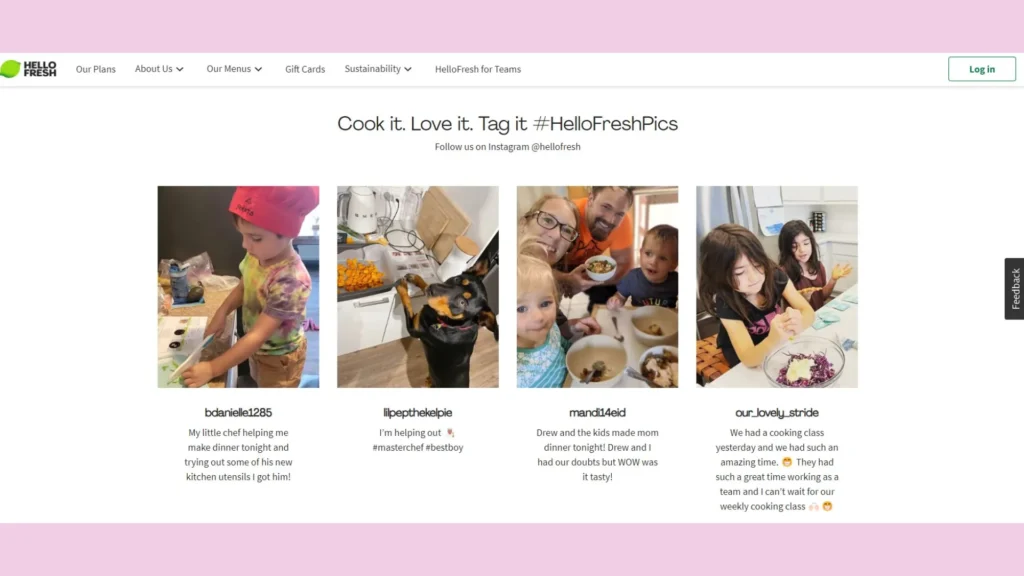
11. Partner With Review Platforms
Depending on your business, collaborating with reputable sites such as Google Reviews, Yelp, or Trustpilot may help you reach a larger audience and develop trust.
- Google Reviews: This platform applies to most industries. Potential customers may see it thanks to Google Search.
- Yelp: Mostly brick-and-mortar companies in the US, Canada, UK, Ireland, and Australia. Retail, dining, and home/local service are Yelp’s three most reviewed businesses.
- Trustpilot: A worldwide platform gaining popularity throughout Europe. Trustpilot suits e-commerce, retail, travel, banking, and professional services.
This list is not exhaustive; the best tools for your firm depend on its type and target audience. You may do research to determine which websites your target customers like.
12. Run Review-Driven Content Campaigns
Positive reviews are full of useful information. Run user-generated content campaigns to increase reviews, highlight the advantages of your goods, and build brand trust with a larger audience.
Including reviews in your product launch is a fantastic strategy to get support. Like Banana Republic did, they share the reviews of others to pique consumers’ interest in your new product.

Or, look at our favorite examples from At Home. They used star ratings and excerpts from 5-star reviews in an email that showcased their top-rated items.
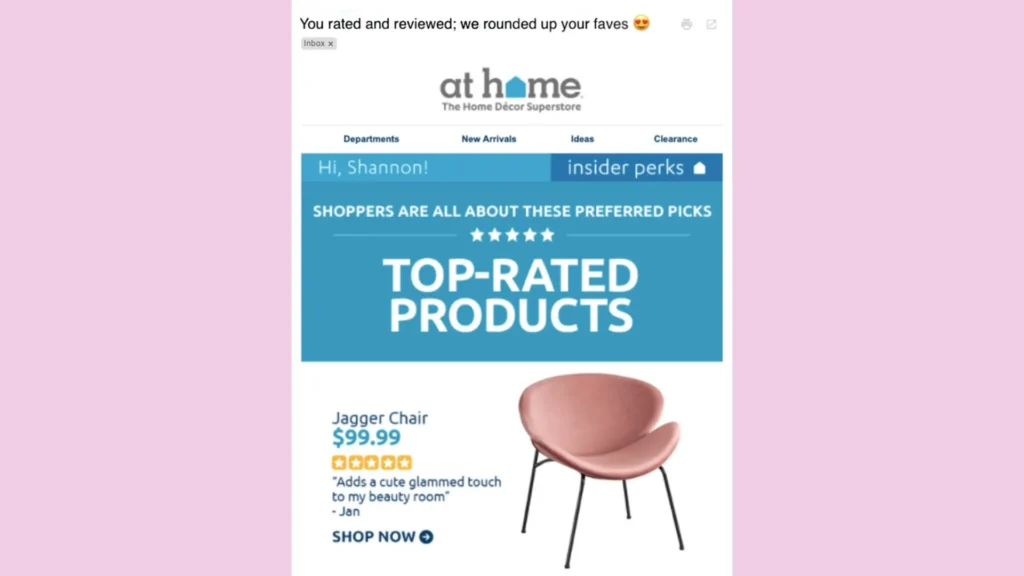
13. Encourage Employee Advocacy
After friends and family, customers believe workers are the most important source of information. By letting your staff post positive customer reviews, you can use their social networks to spread these important testimonials to more people.
This creates a feeling of community and establishes your business as one that prioritizes customer satisfaction. Recall that the goal is to develop a culture of brand passion among your staff members who can engage in it rather than imposing a program.
14. Offer Ongoing Support
Harvard Business Review research highlights the value of establishing long-lasting connections with customers. Offering continuing support to customers that you care about their experience beyond the review bonds them.
Look at Baking Steel’s thank-you email. It’s easy to understand and works well, which helps the company achieve. A welcome or thank you note would have been nice, but the email will keep people interested.
An excellent example is the “thank you for subscribing” email from the Alastin brand. There’s a warm and inviting tone to the text, and the design is simple yet effective. You’ll immediately get the sense that you’re a part of something special.
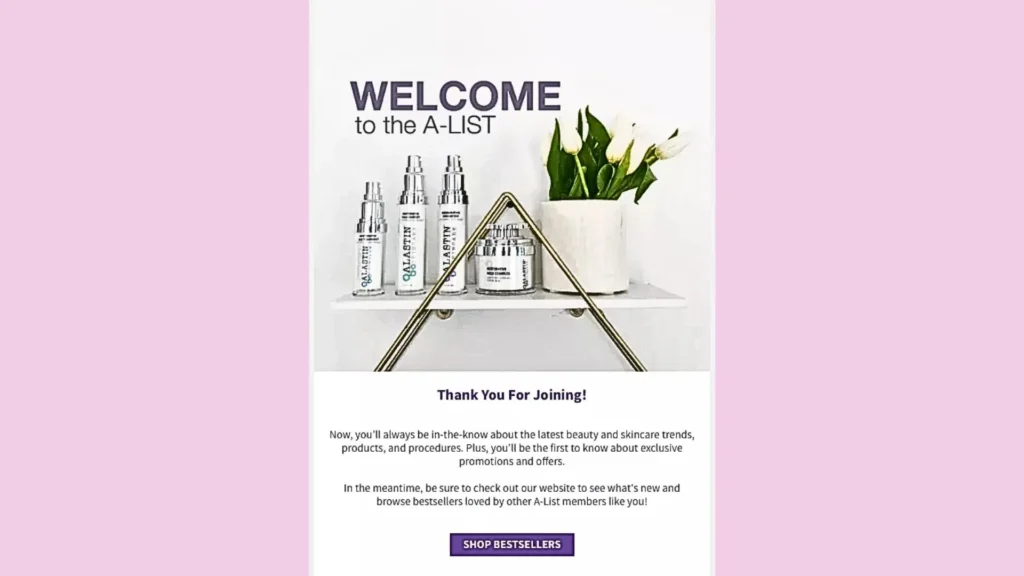
6 Tips To Encourage Customers To Leave Reviews For Your Online Businesses
Here, we’ll go over six useful tips that have less to do with incentivizing reviews and more to do with enhancing the review process overall.
1. Crafting The Perfect Incentive Offer
Undoubtedly, incentive review offers may be successful. However, the trick is to create incentives that are tailored to your target audience.
Here are some creative ways to incentivize online reviews:
- Budget-conscious buyers: discount offers or cashback are a safe bet. Offer a percentage discount or cashback on their next buy for leaving a review.
- Value-seekers: For consumers who pay for shipping, free shipment is appealing.
- Socially responsible shoppers: To attract socially conscious customers, offer to contribute part of the revenue to a charity for each review.
- High-value customers: Consider unique discounts, early access to new items, or exclusive event invites for repeat buyers or insightful reviewers.
Take a look at Derma E as an example. You can get a code for 20% off their “firm + lifting collection” if you write an online review. If you give people a reason to share their ideas on an anti-aging solution, they are likelier to do so.
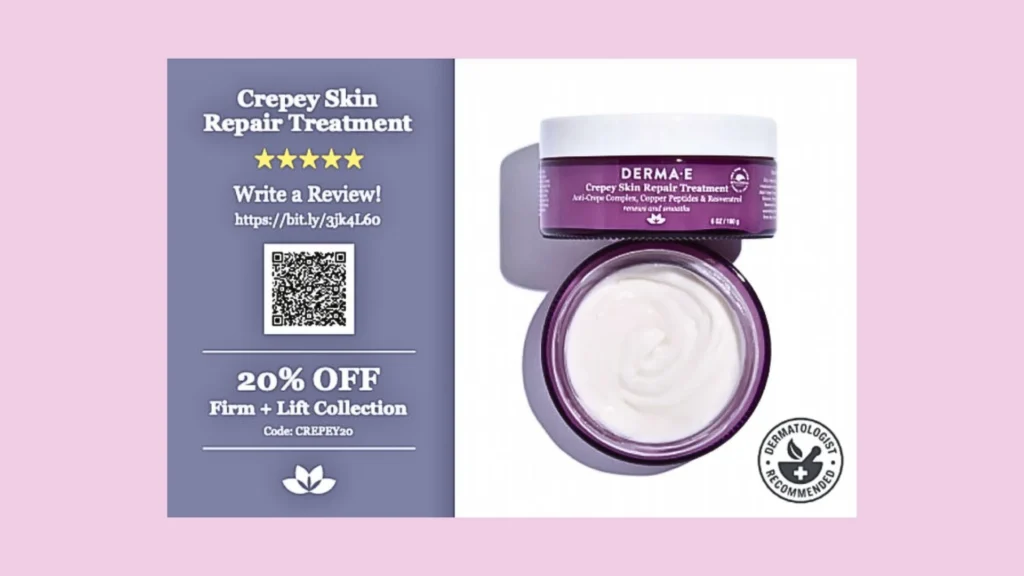
Pro tip: Want to encourage customer reviews and engagement? BON Loyalty integrates smoothly with LAI Product Reviews, Judge.me Product Reviews, and Fera Product Reviews. BON enables retailers to award points to customers for submitting reviews, which can then be redeemed for a variety of perks.
Moreover, this top-recommended Shopify loyalty app allows you to:
- Create the perfect incentive offer: Offer customizable rewards points for discounts, free delivery, or exclusive goods to encourage reviews.
- Targeted Incentives: Providing bonus points for detailed and helpful evaluations increases review volume.
Ready to receive more and more reviews and enhance brand loyalty? Get a free trial BON Loyalty on Shopify App Store now.
2. Setting Clear Guidelines And Call-to-Actions
Clear rules and appealing calls-to-action (CTAs) help the review process and promote consumer participation.
This one from Bissell, for instance, clearly rules that reviewers will be placed into a $1,000 competition.
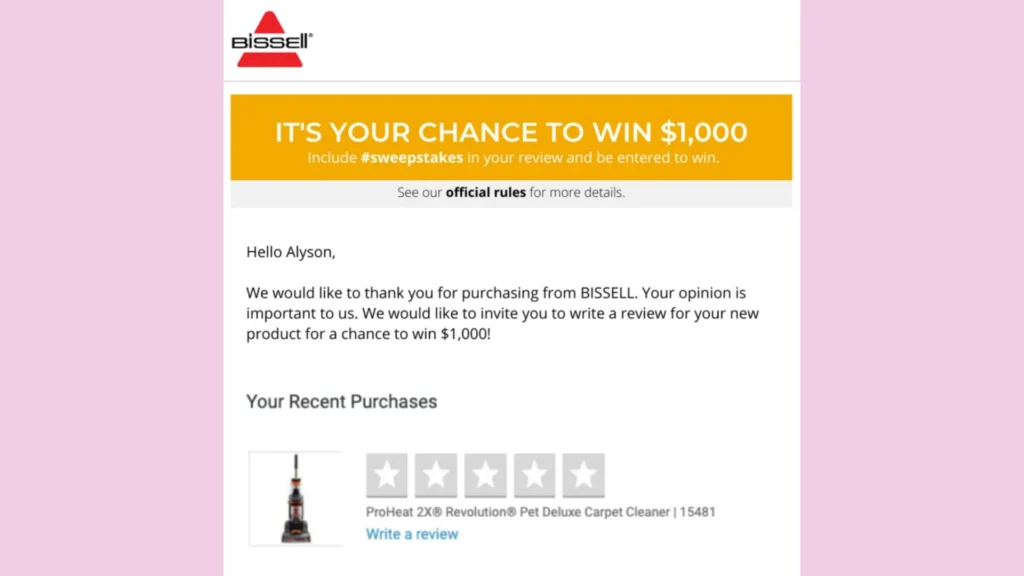
Here are some tips for you:
- Put action words in your CTA: For instance, “Write a Review,” “Share Your Experience,” or simply “Let Us Know What You Think.”
- Make your CTA pop with a bright web design: Using negative white space and minimal clutter around calls to action increased a company’s conversion rate by 232%, as shown by VWO. This draws the reader’s attention to the most important part of the content.
- Make your CTA clickable: Leighton Interactive revealed that button CTAs had the highest click-through rate (CTR) of 5.31%, compared to 4.23% for all other CTAs.
A straightforward email like the one below from Vuori with a call to action button will be effective. Keeping text to a minimum is mobile-friendliness since most individuals will read your email on a mobile phone.
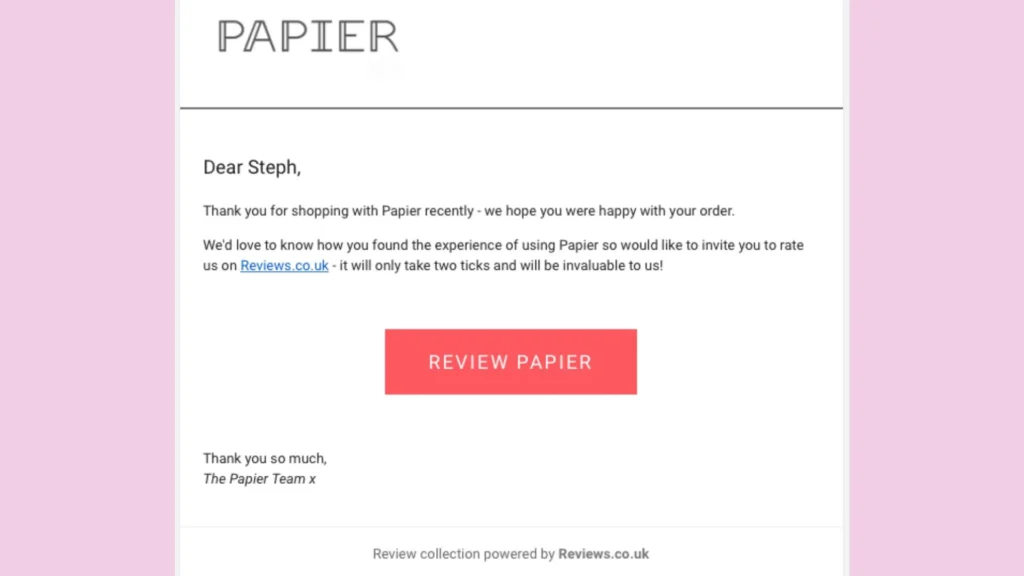
3. Making The Review Process Frictionless
Making the review process easy is critical for increasing participation. This will make it easier for customers to leave useful comments by making the trip easier and making it work best on mobile devices.
- Easy Review Forms: Display star ratings, titles, and open-ended comments. Avoid long surveys.
- One-Click Reviews: Let customers rate stars at once. This suits mobile and time-pressed consumers.
- Guest Reviews: Allow guest reviews to lessen entry barriers.
- Mobile-Friendly Review Widgets: Smartphone reviews should be as easy as PC reviews.
For example, ColourPop Cosmetics, a beauty business, employs various methods. Their review forms are simple. This simplifies customer input at many touchpoints.
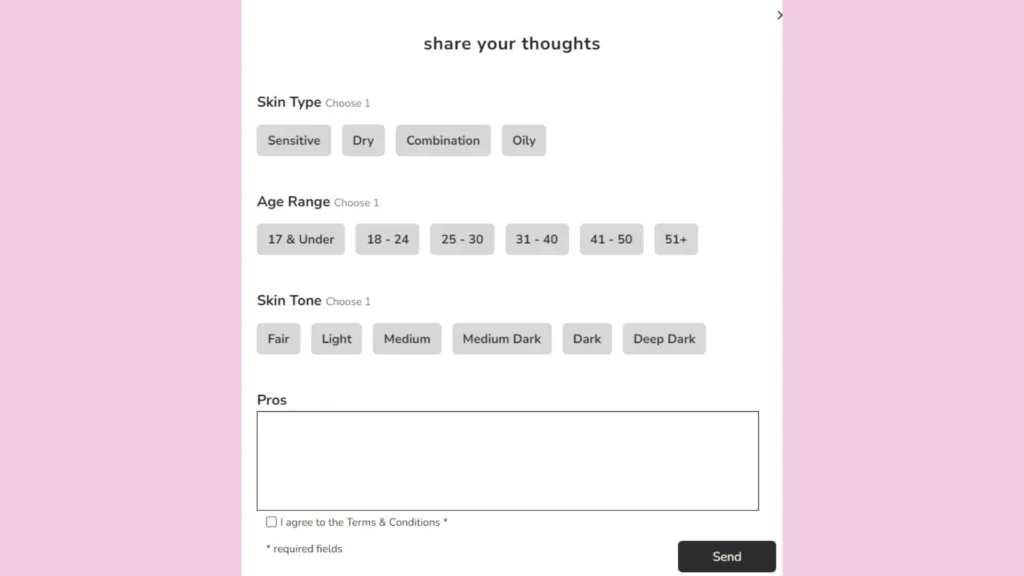
4. Multi-Channel Requests (Email, SMS, Social Media)
Omnichannel initiatives create a 494% higher order rate than the ROI of single-channel advertising. The same concept applies when soliciting reviews. Taking different approaches allows you to reach more people and meet their needs.
As before, you may create a hashtag on social media to encourage consumers to leave online reviews on their accounts and connect them to your website.
Also, look at Charlie Hustle; you may consider including review forms in your emails. These cutting-edge additions make it even simpler for consumers to provide feedback by allowing them to do so within the email.
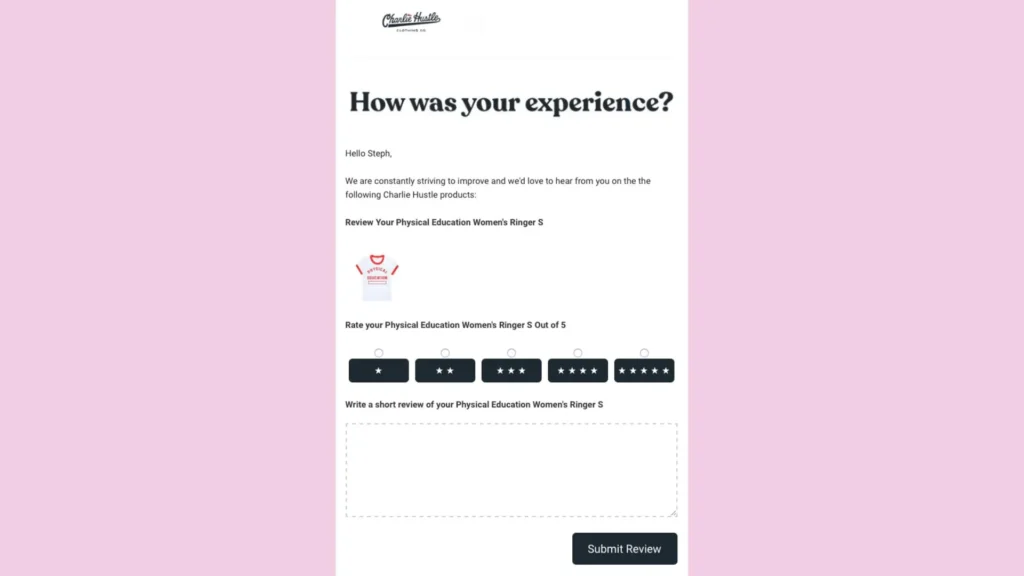
5. Choose The Right Time To Ask For Reviews
Timing is crucial when requesting customer reviews. The ideal moment depends on the type of product or service you offer.
Aim for emails when the buyer is still thinking about the purchase but has had the opportunity to try the goods. As Graham Charlton (SaleCycle) advises, this sweet spot might occur 1 to 2 days after receiving the products.
However, the sort of products you buy should affect your question. Charles Ave Marketing’s Kim Kohatsu suggests:
“If your product is, for example, a skin cream, wait until enough time has elapsed from delivery for the customer to notice the product’s effects.”
For ongoing service businesses, Kurt Uhlir (ShowCase IDX) suggests asking for reviews at key points in the customer relationship.
6. Automating Review Requests After Order Fulfillment
Automation sends pre-written emails or SMS messages following order fulfillment, eliminating this load. This allows you to contact every consumer and concentrate on other company matters.
Here are some suggested technologies for automated review requests following order fulfillment, organized by e-commerce marketing type:
- Shopify.
- BigCommerce.
- Wix Ecommerce.
- Klaviyo.
- Mailchimp.
- Reviews.io
These companies save time, ensure that each customer receives the same treatment, and simplify the process by automating review requests following order fulfillment.
An example of a review request automation technology that Sun Of A Beach uses is Reviews.io. These solutions interact with their e-commerce platform and provide customizable email templates and product category or order type triggers.
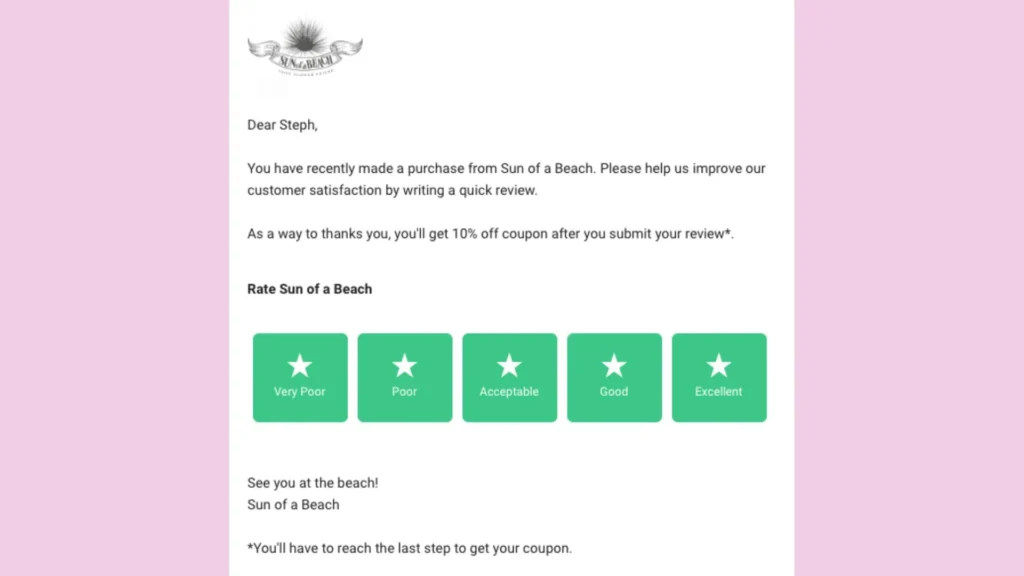
Conclusion
Using the 14 innovative motivational strategies and 6 practical recommendations to increase reviews in this blog article, you can encourage consumers to submit reviews. Remember, genuine reviews authenticate your brand, boost organic growth, and boost sales through word-of-mouth marketing.
Remember that BON Loyalty – The top-recommended Shopify loyalty app makes creating a customized rewards program for your Shopify online store easy. This app lets you create a loyalty program beyond reviews to encourage repeat purchases and brand loyalty.
For more great tips for encouraging customer reviews and customer retention, read our blog.
Lindsey Nguyen is a Content Marketing Specialist at BON Loyalty, specializing in digital marketing and eCommerce. At BON Loyalty, she crafts content that empowers Shopify store owners to build and sustain thriving customer relationships through innovative loyalty programs. Her articles, often featured on the BON Loyalty blog, provide valuable strategies and insights that help businesses enhance customer loyalty and increase customer lifetime value.


